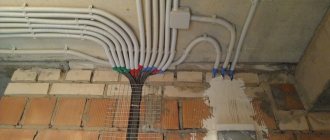Electrical installation in a new building
Today, before moving into a new building, in most cases additional expenses are required, since apartments in new buildings are rented out without renovation. It is necessary to connect electrical systems for electric stoves (high-rise buildings are not connected to the gas supply) and the use of household appliances. Therefore, the speed of settlement, as well as the comfort and safety of life, depends on how correctly and quickly the installation of electrical wiring is planned and carried out.
Electrical installation of a one-room apartment in a new building
Electrical installation of a two-room apartment-new building
Electrical installation of a three-room apartment-new building
Today, before moving into a new building, in most cases additional expenses are required, since apartments in new buildings are rented out without renovation. It is necessary to connect electrical systems for electric stoves (high-rise buildings are not connected to the gas supply) and the use of household appliances. Therefore, the speed of settlement, as well as the comfort and safety of life, depends on how correctly and quickly the installation of electrical wiring is planned and carried out. life activity. life activity.
Our prices
| Prices for electrical installation in a new building: | ||
| ECONOMY | ||
| One-room apartment (up to 35 sq.m; 16 electrical outlets; box up to 12 mod.) | from 35,000 rub. | up to 45,000 rub. |
| Two-room apartment (up to 45 sq.m; 18 electrical outlets; boxing up to 36 mod.) | from 45,000 rub. | up to 55,000 rub. |
| Three-room apartment (up to 60 sq.m; 28 electrical outlets; boxing up to 48 mod.) | from 60,000 rub. | up to 75,000 rub. |
| area over 60 sq.m. | 1200 rub. per sq.m. | |
| AVERAGE | ||
| One-room apartment (up to 35 sq.m.; 16 electrical outlets; box up to 36 mod.) | from 45,000 rub. | up to 60,000 rub. |
| Two-room apartment (up to 45 sq.m; 18 electrical outlets; box up to 48 mod.) | from 70,000 rub. | up to 75,000 rub. |
| Three-room apartment (up to 60 sq.m.; 28 electrical outlets; box up to 54 mod.) | from 80,000 rub. | up to 90,000 rub. |
| area over 60 sq.m. | 1500 rub. per sq.m. | |
| MAXIMUM | ||
| One-room apartment (up to 35 sq.m; 16 electrical outlets; box up to 48 mod.) | from 60,000 rub. | up to 70,000 rub. |
| Two-room apartment (up to 45 sq.m; 18 electrical outlets; boxing up to 54 mod.) | from 80,000 rub. | up to 90,000 rub. |
| Three-room apartment (up to 60 sq.m.; 28 electrical points; boxing up to 27 mod.) | from 90,000 rub. | up to 120,000 rub. |
| area over 60 sq.m. | 2000 rub. Per sq.m. | |
View full price list
| № | Name | Unit | Price |
| 1 | Installation of internal electrical panel (box) up to 12 modules | PC. | from 3200 rub. |
| 2 | up to 24 modules | PC. | from 4600 rub. |
| 3 | up to 36 modules | PC. | from 5100 rub. |
| 4 | up to 54 modules | PC. | from 6200 rub. |
| 5 | Cable laying (1.5 sq. mm - 4 sq. mm) in a corrugation (corrugation fastening) | linear meters | 85 rub. |
| 6 | Laying the power cable (6 sq.mm - 35 sq.mm) | linear meters | negotiable |
| 7 | Installation of electrical box | linear meters | 100 rub. |
| 8 | Installation of cable in a groove with subsequent insertion | linear meters | 70 rub. |
| 9 | Installation and wiring of a single-pole ABB circuit breaker (in the switchboard) | PC. | 170 rub. |
| 10 | Installation and disconnection of the ABB, Legrand difavtomat | PC. | 310 rub. |
| 11 | Installation of introductory automatic machine ABB, Legrand | PC. | 500 rub. |
| 12 | Installation and connection of an electric meter | PC. | 800 rub. |
| 13 | Installation of socket, switch (internal) | PC. | 250 rub. |
| 14 | Installation of socket, switch (external) | PC. | 250 rub. |
| 15 | Installation of external electrical box 10 -25 mm | linear meters | 80 rub. |
| 16 | Installation and wiring of an "Amstrong" type lamp | PC. | 280 rub. |
| 17 | Installation and disconnection of a spotlight (plasterboard) | PC. | 290 rub. |
| 18 | Installation and connection of a 12V step-down transformer | PC. | 200 rub. |
| 19 | Chandelier installation | PC. | from 400 rub. |
| 20 | Installation of sconces | PC. | 250 rub. |
| 21 | Setting the bell (with button) | PC. | 700 rub. |
| 22 | Installation and disconnection of instantaneous (storage) water heater | PC. | from 1500 rub. |
| 23 | Connecting a washing machine | PC. | from 1500 rub. |
| 24 | Dishwasher connection | PC. | from 1500 rub. |
| 25 | Electric floor heating devices | sq.m | 650 rub. |
| 26 | Installation and disconnection of the heated floor controller | PC. | 400 rub. |
| 27 | Fan installation | PC. | 300 rub. |
| 28 | Installation of video intercom (with call panel) | PC. | 6000 rub. |
| 29 | Installation of the ground loop (turnkey) | PC. | from 15,000 rub. |
| 30 | Digging a trench 400 x 700 mm (with installation of an armored cable in a HDPE pipe, backfilling with 150 mm sand, laying warning tape, backfilling) | linear meters | 1100 rub. |
Show in full
Stage of planning and calculation of the electrical network
The main stage in any business is planning. And electrical wiring installation is no exception. No, you won’t need to draw drawings or perform complex calculations, but it won’t hurt to sketch out an apartment plan. But let's talk about everything in order.
Planning the electrical network of the apartment
First of all, we need to decide on the number of electrical points in the entire apartment. For some, this task may seem overwhelming, but there is nothing difficult about it. This will be especially easy if you already have a rough plan for the arrangement of furniture and the design of all the rooms. It is correct to create a scheme precisely after developing such a plan.
Lighting standards for various rooms
- To do this, first of all, we determine the number of lamps, their type and location. Let's start with the number of lamps. It should be such that the lamps provide minimal illumination in the room. According to SNiP 23-05-95, the minimum illumination in living rooms and kitchens should be 100 lux, and in corridors and bathrooms 50 lux.
Luminous flux of various lamps
- A simplified determination of the minimum illumination can be made by dividing the total luminous flux of the lamps by the area of the room. For example, let’s take an 8W LED lamp that emits a luminous flux of 650lm and divide it by a room area of 10m2. We find that such a lamp will be enough for a corridor, but not enough for a living room.
Note! The standards provide the minimum permissible illumination. And to create comfortable conditions you will need to increase this figure by 2-3 times.
Types of lamps
- Now let's decide on the type of lamps. It could be a single-lamp spotlight, or it could be a multi-lamp chandelier. This parameter entirely depends on the design of the room and your preferences. The main thing is to ensure minimal illumination.
Options for placing lamps in the room
- Now let's talk about their location. This is important in the context of creating uniform general lighting. After all, for maximum comfort, lamps must provide uniform illumination of the entire area of the room. For this purpose, an indicator such as the ratio of maximum and minimum illumination has been specially introduced. But it is used in calculations of industrial facilities.
- If you are planning local or decorative lighting, then it should be taken into account separately. This will be important when choosing control locations.
- Our lighting will be turned on with a switch or dimmer. We do not consider more complex intelligent systems, since it is almost impossible to implement them with your own hands. There may be one or more switches for the estimated number of lamps. Therefore, it is better to immediately decide where they will be installed and calculate their total power.
- The total power is quite easy to calculate. To do this, we simply sum up the power of all the lamps that one switch will turn on. If there are several switches for one group of lamps, then we calculate the total power for one of them.
Ohm's law
- But in the future we will need to know the rated current for this switch. Therefore, we use Ohm’s law and divide the resulting power by the voltage - 220V. The resulting value will be the rated current. We will need this parameter to select the switch itself and for further calculations.
- Further, the instructions require us to count the number and power of sockets. If we have a plan for each individual room, then we simply plan one outlet for each or group of household appliances.
An example of calculating sockets in a room
- For example, in the living room we will have a TV - one socket, an audio system - two sockets, a projector - three sockets, an air conditioner - four sockets, on the coffee table we will charge gadgets - five, or even six sockets, and so on. As a result, we get the required quantity.
Approximate power of various electrical appliances
- Now, as in the case with lighting, we need to calculate their rated current. Only now it’s not the total current, but the current of each individual outlet. But if everything is more or less clear with a socket for a TV or other non-movable equipment, then what to do with sockets that are designed to connect a variety of devices? In this case, we select the most powerful of them, and make further calculations specifically for it.
- We carry out similar operations for each room in our new building. At the same time, we think through everything in detail, not in parts, and at the same time, we don’t save much.
Calculation of the electrical network of the apartment
Next, the electrical wiring in a new building is done by calculation. But don't be alarmed, there's nothing overwhelming about it. We performed the main calculation in the last paragraph. Now all that remains is to distribute our sockets and lighting network into separate groups.
Apartment power supply groups with load distribution
- The correct distribution of all electrical network receivers into groups is one of the most important keys to success. It determines whether your electrical network or individual groups will not be overloaded, which will accordingly reduce the likelihood of overheating of the wires.
- There are two options for distributing loads into groups. The first option, most actively popularized by the Internet, is distribution by load type. In this case, the sockets are powered from one group, and the lighting from another.
- The second option is when both lighting and sockets are powered from the same group. These are the so-called mixed groups.
Mixed apartment power supply groups
- What are the advantages of the first option? You have one to three lighting groups per apartment, which are in no way connected with the more vulnerable groups of sockets. In each room, you can turn off the lights, but leave the sockets working and vice versa. You can install RCD circuit breakers only on the socket groups where they are needed, and not install them on all power supply groups.
- But I’ll be honest, I’m a supporter of the second option. On the one hand, this does not seem very convenient when both lighting and sockets are powered from one group circuit breaker, but this also has its advantages.
- Mostly such groups are formed on a territorial basis, that is, one group powers all electrical equipment in one to three rooms. Accordingly, you need to install only one group wire in each room, and not two as in the first option.
- Again, there is less chance of getting confused during installation. In emergency situations, you can simply turn off the power supply to each individual room, rather than looking for a second circuit breaker and remembering the wiring diagram. And finally, another advantage is the price, which will be much lower due to the smaller number of wires required for installation.
Single-pole group circuit breaker for 16A
- Based on this, in the future we will talk about distribution into groups for a mixed scheme. To do this, we need to sum up the rated current of the sockets and lighting networks in each room until we get a number close to, but less than 16A. We have already calculated the rated currents above, so we simply add them up.
- Each such group of electrical appliances with a sum of rated currents close to 16A will form one power supply group. If you carry out the calculation simply by simple summation, then you may end up with two or even three groups needed for one room.
- But here you should be flexible and calculate the probability of connecting all electrical appliances to the network at once. It's probably low. Therefore, the calculation should be made based on the most unsuccessful, but realistically possible options.
Distribution of loads throughout the apartment in a mixed group
- Why 16A? This is due to the fact that clause 9.6 of VSN 59 - 88 requires group power supply circuit breakers in residential premises to be installed with a current of no more than 16A.
- A separate issue is electrical appliances with a rated power of 2.5 - 3 or more kW. Usually these are stationary devices and a separate group should be organized for them, which will power only this electrical device.
- Another special case is the electric stove. If you are laying the electrical wiring yourself in a new building under an electric stove, then you should definitely install a separate group circuit breaker for it. Moreover, its rated current must be no less than 25A.
Note! In very rare cases, a three-phase power supply network is created for electric stoves. In this case, the rated current of the three-pole circuit breaker will be about 16A. This is a positive point, but in this case the furnace connection diagram will be slightly different. We have already discussed connection options on the pages of our website, so we will not go into details again.
Apartment power supply
- Another aspect that should definitely be taken into account is the inadmissibility of combining electrical appliances from the bathroom and kitchen with electrical receivers in living rooms in one group. This is stated in paragraph 7.2 of VSN 59 – 88.
- As a result, you should get about 2 – 4 groups for a one-room apartment, and 3 – 6 for a three-room apartment. But this all depends on the amount of electrical equipment and is a fairly arbitrary value.
Carry out electrical wiring in a new building on a turnkey basis
Many people decide to save money and do everything themselves, without involving specialists. This solution is quite viable, but only if the homeowner has experience in electrical work, time and technical capabilities. But in most cases it is better to trust the professionals in their field.
Qualified specialists have extensive experience working on a variety of projects, including new multi-storey residential buildings, for which we provide the following services:
- Calculation of power lines taking into account the number of electricity consumers
- Checking cable lines
- Creation of an electrical project (if necessary)
- Replacement of electrical installation products (sockets, switches, etc.)
- Creation of low-current networks (telephony, TV, intercom, Internet, etc.)
- Full/partial replacement of electrical wiring
Selection of electrical installation products and wires
Often, insufficient attention is paid to this issue, and therefore, sockets and switches burn out, and the wiring melts.
Now, in order for our electrical wiring and the new building as a whole to last a long time, we need to choose the right electrical installation products and wires:
| Let's start with choosing switches. First of all, we are interested in the rated current of these devices. It should be higher than what we calculated for the sum of lamps for each connection. Switches come in 6 and 10A ratings. If you plan to install diode or fluorescent lamps, then 6A is usually enough. If more expensive lamps are used, a 10A switch may be required. |
| When choosing sockets, we are also interested in their rated current. It can be 6, 10, 16 and 25A. The choice should be made based on the current rating of the most powerful device that can be connected to the outlet. We have already calculated this parameter, and it should not raise any questions for you. |
| Now we come to the choice of wires. According to table. 7.1.1 PUE the minimum permissible cross-section of copper wire for group lines is 1.5 mm2. If we rely on Table 1.3.4 of the PUE, this is quite enough for a current not exceeding 16A. But it will not exceed this value, since the rated current of the group circuit breaker is 16A and if this value is exceeded, it will turn off. If you want greater reliability, you can take a wire one or two points higher - this is 2.0 or 2.5 mm2, respectively. But that's up to you. A high-quality wire of 1.5 mm2 is enough for a current of 16A |
| Now, as for the wires extending from the group wire to individual electrical receivers. They can be selected according to the table. 1.3.4 PUE based on the rated current of this device. But I would advise you not to bother and do all the wiring with the same section of wire. This will simplify the work, and the savings on wire cross-section are not that significant. |
| This is all the mandatory electrical equipment that you will need, but besides it, there is a whole range of devices that are not mandatory, but are recommended. First of all, these are RCD machines. They provide protection to a person from electric shock when touching damaged electrical equipment. According to the PUE standards, the leakage current of such devices for residential premises should be no more than 30 mA. |
| Although an RCD may be mandatory for installation. If you plan to have an outlet in the bathroom, then such a protective device is required for this group. Although you can do without it. Now there are sockets with a built-in RCD circuit breaker, which will allow you to do without a group circuit breaker. |
| But RCDs are not all protective devices. There are also so-called surge suppressors. They will turn off the power to all groups when the voltage increases or decreases to a specified value. This will reduce the likelihood of electrical equipment failure. |
| Another optional, but recommended for installation, is a power quality controller. It detects and records any fluctuations and deviations in the network. But if you plan to later go to court with this data for damages, then such a device must be certified in our country. |
Note! Since 2001, the use of aluminum wires for wiring in residential premises is prohibited. Therefore, we carry out calculations only for copper wires.
Electrics in a new building: reliable, high quality and inexpensive
– this is your chance to get the electrical work done quickly, efficiently and in compliance with all the deadlines specified in the contract. By contacting us for help, you get the following benefits:
- Professionalism of specialists - we employ real masters of their craft with experience of 5-10 years and above
- Personal approach and individual price - we calculate the cost of work strictly taking into account the characteristics of your apartment, and do not offer unreasonably high prices to everyone
- Efficiency is our goal, so that you move into the long-awaited apartment as soon as possible, so we will install everything in the shortest possible time!
- Warranty on all work – 5 years
A specialist’s visit to the site for consultation is FREE!
Rules for different types of wiring
When choosing wiring for equipment of various types of premises, you should follow the rules set out in GOST 12.1.044. For residential buildings, you need to use three-core cables with copper cores of 1-2.5 mm. The insulation must be non-flammable and not emit smoke when heated. The brands VVG-Pngd, VVGzngd, Flame-X, N2XH, YnKY correspond to these parameters.
For the arrangement of premises made of non-combustible materials, the use of simple conductors is allowed without any restrictions. Powerful consumers operating in continuous mode must be connected to a separate line equipped with an RCD.
Electrical installation in a new building includes
- Visit of a specialist, diagnostics of the object
- Drawing up a diagram of the location and quantity of electrical appliances, sockets, switches (based on an electrical project, design project)
- Drawing up an estimate for electrical installation work
- Wall chipping, installation of socket boxes (after plastering the walls)
- Installation of all necessary power and low-current cables
- Electrical panel installation
- Checking all power lines (before finishing work)
- Finishing work
- Installation of sockets, switches, lamps, automation
- Commissioning works
How to pull a cable
Wiring to the electrical panel is possible in two ways:
- on the floor with corrugation or without corrugation (in a new building);
- Stretch along the ceiling .
In both cases, the wires will be laid correctly and securely fastened, but exactly how the route needs to be laid will depend on what kind of ceilings there will be in the apartment (gypsum plasterboard or tension) and what the difference in the base is. Call: 8(499)397-78-90
Electrical wiring in a new building
The routing of rough electrics on the floor can be used in case of further leveling of the surface. This option is most often used in a new building, before leveling.
Pulling the cable under the bulk solution
If the difference in the base is up to 20mm, the wires can be fixed to the floor without corrugation, after which the base can be leveled (the wiring will be securely closed under the layer of mortar). Of course, you need to buy a high quality cable, preferably NYM (GOST), which includes triple insulation of the wire. If the level of difference is 30mm or higher, electrical installation can be done in corrugations, after which they will be covered with a layer of screed (dry or wet). It is necessary to take measurements for an accurate determination.
The next stage of repair
When the electrical cable is routed throughout the apartment, you can proceed to the next stage: repairing the floors. Then switch to walls and finishing.
Circuit examples
Table of power consumption of various electrical appliances.
Cable laying from the panel and meter to sockets and lighting devices is carried out according to the wiring map. The studio is a one-room apartment in which the walls have been demolished and do not perform a load-bearing function. The presence of free space makes it possible to install a large number of electrical installations of various capacities. Based on this, it is necessary to divide consumers into groups and connect separate lines to them through package switches.
Example of grouping directions:
- Powerful devices - 32 A.
- Household appliances - 16-25 A.
- Lighting group - 10-16 A.
The installation of the electrical network for multi-room apartments is carried out in a similar way. It is advisable to allocate space for the input panel, in which package switches are installed, from which there is a line to each room.
Wiring directions and their characteristics:
- Living rooms - 16-25 A.
- Kitchen - 32 A.
- Bathroom - 25 A.
- Corridor - 8 A.
- Balcony (loggia) - 8 A.
This solution is good because you can de-energize one room if there is a need to hang a chandelier or replace an outlet or switch.











